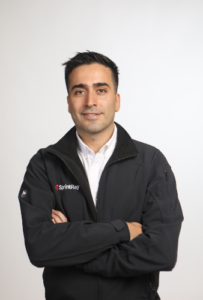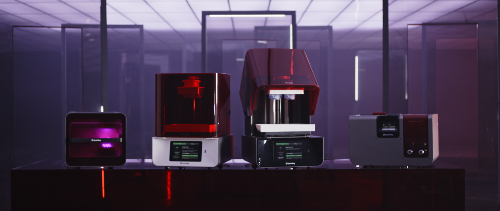A typical dental impression or mouth scan for a crown or nightguard device can take a couple of weeks to manufacture and requires a couple of patient visits to complete.
But now, with new 3D-printing technology from Glassell Park-based SprintRay Inc., the finished dental product can be printed out within an hour at the dentist’s office while the patient waits. No more sending out the impressions or scans to a third-party lab.
“This is the new model of dentistry: offering the finished crown or nightguard to the patient within an hour,” said Amir Mansouri, SprintRay’s chief executive. “It means less visits for the patients as well as less work and cost for the dentist.”

SprintRay doesn’t do the actual 3D printing of the dental products. Rather, it sells 3D printers through distributor networks to dental practices. It’s the dentists themselves who print out the products, after some initial training and guidance from SprintRay.
Although SprintRay declined to disclose revenue, the company said demand for the printers has been robust enough that last month it opened a new 40,000-square-foot facility in Glassell Park to make and assemble the printers and to train dentists and members of the distributor networks on how to use them.
USC engineering roots
Printing dental products wasn’t in the initial vision when Mansouri gravitated to 3D printing as a doctoral student at USC specializing in additive manufacturing. While the university program was more focused on research and future possibilities for 3D printing such as construction of living quarters on the moon, Mansouri said he felt the time was right to pursue more immediate opportunities for commercial applications of the technology. He connected with fellow USC student Jing Zhang and with industrial designer Hossein Bassir, who was based in Malaysia. The three co-founded SprintRay in late 2014, and after an online Kickstarter campaign that raised nearly $450,000, they were ready to launch the company.
Trouble was, they didn’t know what to focus on, Mansouri said. The technology was so new that a lot of application ideas were floating around but with little to show for them.
3D printers take designs and parameters scanned into them and then print out products using special resins. The possibilities for printing out three-dimensional products are almost limitless.
“The question then was what we were going to print,” Mansouri said. “We had customers from the jewelry industry come in and consider our 3D printers for custom jewelry. We had engineers come in and want to buy the machines for prototyping.”
But then a large Newport Beach dental lab, Glidewell Laboratories, bought a one of SprintRay’s printers. By this time, in 2017, 3D printers had shrunk to tabletop size, and Glidewell was looking to replace an earlier, much-larger model from another company. After some adjustments were made to the printer, Mansouri said Glidewell boosted its order to more than 40 of the printers.
“That was the point where we at SprintRay sat down and decided to focus on the dental market,” Mansouri said.
But in another key decision, SprintRay chose to focus on dental offices, not dental labs. For starters, Mansouri said, there are many more dental offices than labs. Also, he said, selling to dental offices could allow those offices to bypass dental labs entirely and make the dental products themselves. And at a cost of about $14,000 for the printer and accessories, it was an affordable investment for dentists.
Early adopter
One of SprintRay’s earliest dental office customers was Steven Shao, a dentist with Huntington Beach-based Sunrise Dental Center. Shao had been experimenting with 3D printers on his own, outside the dental practice.
When Shao bought one of SprintRay’s printers for the dental practice in 2017, he decided to use it to print out surgical guides and mockups that precisely replicate surfaces of patients’ mouths and teeth, allowing him to practice placing implants. Up until that point, surgical guides and mockups had to be sent out to labs.
Shao said the benefit of the 3D-printer technology went much further than saving time and money bypassing the lab.
“Right from the start, the use of the 3D-printing mockups helped convince patients to go ahead with the procedures where they might not have otherwise or they might have decided to shop around,” he said. “The mockups allowed the patients to see exactly how the finished product would look. This gave us a competitive advantage over other dentists, and it also translated into more treatment cases for us.”
In fact, Shao said, he made back his investment on the very first complex case, in which the 3D-printed mockup helped a patient decide to go through an expensive dental surgery procedure.
“For me, that’s been the biggest benefit: bringing in more business,” Shao said.
As a result, the dental practice bought another three printers. The biggest challenge, he said, was learning how to operate the 3D printers so that they produced dental products with precision.
One-stop shop
Indeed, that need for training is often cited as a reason for the hesitancy of most dentists and dental practices to embrace 3D-printing technology, according to Tim Schmitt, vice president of sales and marketing for Dental Product Shopper, which is published by Manapan, N.J.-based Integrated Media Services Inc.
“The biggest challenge is educating the dentists and the doctors,” Schmitt said. “This is such a new field that it will take a while to get into the mainstream.”
But if and when it does hit the mainstream, he said it has the potential to be a disruptive technology.
“The big game-changer moment will come when it becomes standard practice to 3D-print crowns and implants right in the dentist’s office,” Schmitt said.
He noted that so far, only a handful of companies nationwide have gotten into the market for 3D printing of dental products. It will take a few years until larger companies get their 3D-printing infrastructure in place and begin to offer real competition for companies such as SprintRay, he added.
In the meantime, Mansouri said SprintRay has worked to improve training procedures for its dental office customers.
“We have found you can train the dental office staff to handle most of the troubleshooting issues,” he said. “But we also have a team dedicated to troubleshooting: being able to gain remote access to the printer and see what went wrong.”
He added that SprintRay is also emphasizing the versatility of its 3D-printing machines for dentists.
“If they need a nightguard, we’ll print it,” he said. “If they need an implant, we’ll print it. If they need a crown, we’ll print it. If they need a clear aligner, we’ll print it. Our aim is to become the one-stop shop for 3D-printed dental products.”

